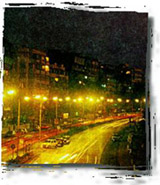 Maharashtra is one of the largest,most affluent and
well populated states of India.Maharashtra state stands high on the
Deccan Plateau and historically, this was the main center for the
Maratha empire, which under the aegis of the great warrior King Sivaji
fought the Moghuls for long.
Maharashtra is one of the largest,most affluent and
well populated states of India.Maharashtra state stands high on the
Deccan Plateau and historically, this was the main center for the
Maratha empire, which under the aegis of the great warrior King Sivaji
fought the Moghuls for long.Maharashtra is a highly industrialized and urbanized state, agriculture is widely spread in the districts.Geographically, it consists of the narrow Konkan coast backed up by the Sahyadri hill ranges of the Western Ghats which ascends to the Deccan plateau and a series of river valleys.The language spoken here is Marathi Mumbai(Bombay) is an island conected to the main land by bridges. Mumbai's main land mark is the Gateway of India. Mumbai is the capital city of Maharashtra, and large populated and well developed Industrialized centre in the country.
Sight seeing: Marine Drive is along the sea coast and is now officially named as Nethaji Subash Road. It was built in the year 1920 on reclaimed land along the sea coast. Facing the sea, there are posh residential apartments on the other side of the road and is one of Mumbai's most popular and elite residential areas.
Other Important places to visit in Mumbai:
Conducted tours:
Ellora caves are situated about 48 kms, away from Aurangabad and extend als on the face of the hill for nearly a mile and a quarter. They are divided into distinct parts,viz: Buddhist, and Jain, which are arranged almost in a chronological order. There are in all 34 chityas and viharas from between the fourth and the ninth centuries. The most splendid place is the Kailasa, which is a Dravidian Temple and the rock here is cut both internally and externally. There are colossal elephants lining either side of the hall. The temple of Lord Siva was built between 760-783 AD. Although much of the carvings inside was damaged by the Muslim invaders at the end of the 13th century, the temple is both a masterpiece of the rock cutters' art and a storehouse of Hindu mythology. Two great dynasties were the patrons of ellora excavations the Deccan and their successors and the Rashtrakutas, who also built the shrine of Elephanta. Ellora caves are remarkable for their splendid sculpture. Among the caves, cave no:5 is the biggest Vihara cave. It is presumed that it might have been the assembly hall. The Hindu caves are the most dramatic and impressive of the ellora cave temples. The sheer size of the Kailasa temple is overwhelming. It is astounding that this whole temple is cut of solid rock. It is estimated that this rock temple involved removing 200,000 tons of rock. It is remarkable that all these temples were cut from the top down, so that it was never necessary to use any scaffolding- their builders started with the roof and moved down to the floor. Krishnagiri Upavan National Park, Kanheri caves, Lion Safari Park are some places worth visiting. Poona is the confluence of the Mutha and Mula rivers. Places to visit in Poona are Rajneesh Ashram, Kelkar Museum, Shanwarwada Palace, National Defence Academy Khadakvasla, Aga Khan's palace, Loin Fort.
Spciality
Tourist Information:
|
 Ajanta caves are not really caves at all, but temples
built out of rocks. They were excavated by gerenations of
Buddhist monks.Ever since the year 200 BC the Ajanta ravine had
been a great monastic centre. Intitially,it used to be a shelter
against the ravages of the monsoon. Cut into the side of the ravine,
there are 30 caves in their cool, silent shadows in which are hidden
the most lovely and important Buddhist paintings in existence-the murals
of Ajanta.
Ajanta caves are not really caves at all, but temples
built out of rocks. They were excavated by gerenations of
Buddhist monks.Ever since the year 200 BC the Ajanta ravine had
been a great monastic centre. Intitially,it used to be a shelter
against the ravages of the monsoon. Cut into the side of the ravine,
there are 30 caves in their cool, silent shadows in which are hidden
the most lovely and important Buddhist paintings in existence-the murals
of Ajanta.